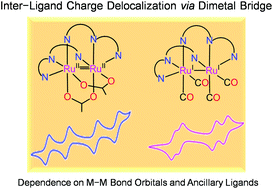Inter-ligand electronic coupling mediated through a dimetal bridge: dependence on metal ions and ancillary ligands†
Abstract
A series of Mo2, Ru2, Rh2 and Cu2 complexes with redox-active NP-R [2-(2-R)-1,8-naphthyridine; R = pyrazinyl (NP-pz, L1) and thiazolyl (NP-tz, L2)] ligands have been synthesized and characterized by X-ray crystallography and spectroscopic methods. Two NP-R ligands wrap the dimetal core by occupying four equatorial positions and two axial sites. The remaining four equatorial sites are engaged by bridging acetates in quadruply bonded cis-[Mo2(L1)2(OAc)2][BF4]2 (1), cis-[Mo2(L2)2(OAc)2][BF4]2 (1A), doubly bonded cis-[Ru2(L1)2(OAc)2][ClO4]2 (3), cis-[Ru2(L2)2(OAc)2][ClO4]2 (3A) and singly bonded trans-[Rh2(L1)2(OAc)2][BF4]2 (5) and trans-[Rh2(L2)2(OAc)2][BF4]2 (5A). Compounds cis-[Mo2(L1)2(CH3CN)4][BF4]4 (2), cis-[Mo2(L2)2(CH3CN)4][BF4]4 (2A), cis-[Ru2(L1)2(CO)4][OTf]2 (4) and cis-[Ru2(L2)2(CO)4][ClO4]2 (4A) contain acetonitriles or carbonyls as the ancillary ligands. The dicopper complexes trans-[Cu2(CH3CN)(L1)2][ClO4]2 (6) and trans-[Cu2(L2)2(ClO4)2] (6A) involve no bonding interaction between two Cu(I) units. Cyclic voltammogram studies reveal that two one-electron processes corresponding to each of the two ligands bound to the metal–metal bonded dimetal core result in four reversible one-electron reductions, with the exception of dirhodium(II,II) compounds 5 and 5A which show two one-electron reductions. The highest comproportionation constant (Kc) values are obtained for inter-valence complexes originating from the diruthenium(II,II) compounds 3 and 3A, whereas no electron delocalization is observed for dicopper(I,I) complexes 6 and 6A. The dimetal bridge and the ancillary ligands tune the degree of inter-ligand electronic coupling in these complexes. DFT calculations reveal a π*(NP)–δ*(M2)–π*(NP) orbital conduit for electron delocalization. For diruthenium(II,II) compounds 3 and 3A, an additional π*(NP)–π*(M2)–π*(NP) pathway is accessible contributing to high Kc values. The ancillary π-ligands (acetates and carbonyls) reduce the extent of the electron flow through π*(NP)–δ*(M2)–π*(NP) and thus lower the Kc values. The absence of metal–metal bond orbitals and the reduced metal–ligand covalency in dicopper(I,I) compounds are responsible for the lack of electron delocalization in these systems.

- This article is part of the themed collection: Multimetallic complexes: synthesis and applications


 Please wait while we load your content...
Please wait while we load your content...